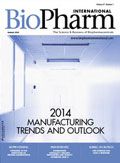Drugs, At What Cost?
Generics, market dynamics, and global demand are changing drug spending patterns.
The underlying question for any drug in development is: What price can (or will) patients pay for the needed therapy? Patient sticker shock, government austerity programs, blockbuster drugs falling off the patent cliff, and varying medical and regulatory practices worldwide continue to shape the financial outlook of biopharmaceutical companies.
In a new report, The Global Use of Medicines: Outlook through 2017, IMS Institute for Healthcare Informatics projects that in 2014 total global spending on medicines will, for the first time, exceed $1 trillion. In 2017, the total will reach almost $1.2 trillion. The report identifies challenges, but also indicates opportunities for the industry to improve the lives of patients.
In 2012, developed markets (United States, Japan, Germany, France, Italy, Spain, United Kingdom, Canada, and South Korea) reduced spending for the first time due to patent expirations, austerity measures, and moves toward generic drugs. Annual growth in spending levels will reach a low point in 2013, the report says, but will rebound from negative $3 billion in 2012 to $20-25 billion by 2017. In emerging markets (more than 20 nations including China, Brazil, India, Russia, Mexico, and Turkey), growth will increase from $26 billion in 2012 to $30-50 billion in 2017, primarily due to increased access to medicines.
In 2017, spending on medicines for specific diseases will differ between mature and emerging markets, the report says. In developed markets, increasingly aged and obese populations drive spending in oncology and diabetes, a trend that is increasing in emerging markets. Specialty pharmaceuticals that treat complex, serious diseases will grow in importance in developed markets; traditional therapies will drive spending in emerging markets.
Biologics have a growing impact on the drug market and prices. In 2002, biologics represented 11% of total drug sales; in 2012, the number was 18%. IMS estimates biologic agents will continue to outpace overall pharma spending growth and will represent 19-20% of the total market value by 2017. Monoclonal antibodies and human insulin will spur this growth.
Competition generated through established biosimilar pathways will drive down the high costs of biologics in Europe, the US, and some emerging countries. However, in markets with less rigorous IP protection, IMS reports a surge in non-original biologics--copies of innovator brands that have not been approved a dedicated pathway. Biosimilars account for less than 0.5% of biologic spending in mature markets; in emerging markets, non-original biologics represent more than 10% of all biologics spending.
The mix of total global spending on medicines will shift toward generic drugs, rising from 27% to 36% of the total by 2017; however, brand drugs will account for more than two-thirds of spending in developed markets. In emerging markets, generic-drug products will represent 63% of spending.
Traditional pharmaceuticals used to treat chronic diseases in primary care will increasingly be dispensed as generics; total spending will only rise 5% by 2017 in developed countries. In emerging markets, total spending on traditional pharmaceuticals is expected to rise from $199 billion in 2012 to $336 billion in 2017 as patients gain access to affordable generic drugs.
IMS reports spending on specialty medicines in developed markets is expected to increase by 30% over the next five years; the use of specialty medicines in emerging markets is at very low levels, but the costs are expected to rise by nearly 90% between 2012 and 2017.
Reference
1. IMS Institute for Healthcare Informatics, The Global Use of Medicines: Outlook through 2017, November 2013.

About the Author
Rita Peters is the editorial director of Pharmaceutical Technology.

VERAXA and Voyager to Create Combined Business for Advancing Pipeline of Next-Gen Cancer Therapies
April 23rd 2025The proposed business combination would create a publicly traded, clinical-stage biopharmaceutical company that will focus on developing a pipeline of next-generation cancer therapies.
Tokyo University of Science Research Team Explores Improved Delivery of Antisense Oligonucleotides
April 18th 2025Using cholesterol-modified oligonucleotides, the research team aims to improve the delivery of antisense nucleotide-based therapies for treating neurodegenerative diseases and brain cancers.